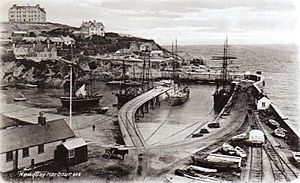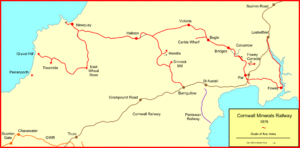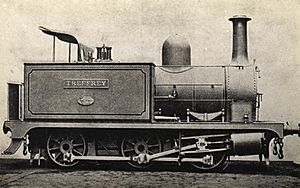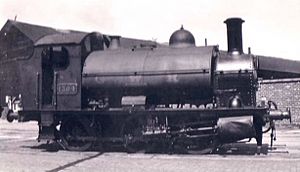Cornwall Minerals Railway facts for kids
The Cornwall Minerals Railway (CMR) was a railway company in Cornwall, England. It owned and ran about 45 miles (72 km) of railway lines. These lines connected important harbours like Newquay, Par, and Fowey.
The CMR started in 1862 by taking over an old railway that used horses. They made it better and built new parts. Even though it was called a "Minerals" railway, it also carried passengers between Newquay and Fowey. The company faced money problems when the price of minerals dropped.
After some financial difficulties, the CMR bought another railway line called the Lostwithiel and Fowey Railway. In 1896, the CMR sold its lines to the Great Western Railway. Today, the main passenger line from Par to Newquay is still used. It's now called the Atlantic Coast Line. Some parts also carry minerals. The line from Par to Fowey is now a private road.
Contents
- Early Railways in Cornwall
- The Cornwall Minerals Railway Begins
- Lease to the Great Western Railway
- After the Financial Troubles
- New Lines and Closures
- Taken Over by the Great Western Railway
- After 1948
- The Railway Today
- Early Passenger Journeys
- Locomotives (Trains)
- The Route of the Line
- See also
- Images for kids
Early Railways in Cornwall
Joseph Treffry's Vision
Joseph Treffry (1782 - 1850) was a rich landowner in Cornwall. He owned many mines. Moving minerals to sell them was very expensive. So, Treffry decided to build better ways to transport them.
He built Par Docks and the Par Canal. This canal connected the docks to Pontsmill. He also built tramways (small railways) that used inclined planes. These tramways helped bring copper and china clay from mines like Fowey Consols to the docks.
In 1844, Treffry built a horse-drawn tramway from the Luxulyan Valley to Molinnis. Later, in 1849, he built more tramways around Newquay. He also improved Newquay Harbour. These lines are known as the Treffry Tramways. They were built to the standard gauge (the usual width between tracks). Treffry wanted to connect all his lines, creating a route between Par and Newquay. This would make it easier to move goods like copper and coal.
Sadly, Treffry became ill and died in 1850. He never saw his dream finished. His railways helped a lot, but because they used horses, they quickly became old-fashioned.
The Cornwall Railway Arrives
People in Cornwall wanted a railway connection to London. But building railways in Cornwall was hard because of the hills and valleys. It was also difficult to find enough money.
After a long time, the Cornwall Railway opened in 1859. It connected Truro and Plymouth. This railway used a wider track width called broad gauge. It linked up with the Great Western Railway (GWR), creating a route from Truro to London.
Newquay and Cornwall Junction Railway
In 1864, a new railway company was formed. It was called the Newquay and Cornwall Junction Railway (N&CJR). This company wanted to connect Treffry's lines at St Dennis to the Cornwall Railway at Burngullow.
The N&CJR built its line using the broad gauge. Remember, Treffry's lines were standard gauge. The N&CJR had big plans to take over and change Treffry's lines. But they ran out of money. Their line only went from Burngullow to Nanpean and opened in 1869.
Lostwithiel and Fowey Railway
Another short railway, the Lostwithiel and Fowey Railway, opened in 1869. It connected Lostwithiel (on the Cornwall Railway) to jetties near Fowey. Fowey was a busy harbour. This railway was meant to carry minerals and goods to the Cornwall Railway system.
The Cornwall Minerals Railway Begins
William Roebuck's Plan
William Richardson Roebuck was interested in mining and railways in Cornwall. He leased Treffry's old tramways in 1872. Roebuck planned to make big improvements. He wanted to use steam locomotives instead of horses. He also wanted to connect the lines and carry passengers.
Roebuck tried to get official permission for his plans. He formed a company called the Cornwall Minerals Railway and Harbour Company Limited. But he had to get permission from Parliament in the usual way.
Getting Permission and Building
The Cornwall Minerals Railway (CMR) got permission from Parliament on July 21, 1873. They could buy and improve the Treffry Tramways. They also got permission to build new lines. These included connections between St Dennis and Molinnis, and Nanpean and Hendra.
A big new line was planned from St Blazey (near Par) to Fowey Harbour. This line would have new jetties (docks) at Fowey. The docks at Newquay would also be improved.
This was a huge project! The CMR had to build new sections of track to avoid old, difficult parts of Treffry's line. They had to build new bridges instead of level crossings. The line to Fowey needed a long tunnel called Pinnock Tunnel, which was 1,173 yards (1,073 metres) long. It was the longest tunnel in Cornwall.
To use locomotives, the CMR needed to buy trains and carriages. They also needed places to fix trains and a proper signalling system. The CMR built a large engine shed at St Blazey for their 18 locomotives. These engines were designed to work in pairs.
The CMR also took over the Newquay and Cornwall Junction Railway. They started running trains on that line in June 1874.
Quick Construction
The CMR worked very fast to build and improve the lines. They opened the full railway on June 1, 1874. This was only 11 months after they got permission!
New Branches and Changes
The old Treffry Viaduct was still used for quarries. In 1874, a stone mill was built at Pontsmill. It used water power. Stone was brought to the mill by train. This mill became very large later on.
The CMR also extended a branch line to Gravel Hill to reach iron ore. This was done without special permission from Parliament.
The original plan for the Newquay and Cornwall Junction Railway said that the line from Drinnick Mill to St Dennis should have mixed gauge tracks. This would allow broad gauge trains from the Cornwall Railway to reach St Dennis. The CMR only laid standard gauge tracks at first. But the Cornwall Railway insisted, and the broad gauge tracks were added in 1875.
Mineral Trade Problems
The mining industry in Cornwall depended on world prices. When the CMR lines opened, cheap iron ore from other countries became available. Many Cornish iron mines closed suddenly. The CMR had agreements with mines to carry their minerals. But the mines couldn't provide the minerals anymore. This caused big problems for the CMR.
China clay production also slowed down. All these issues meant the CMR, which had spent a lot of money, couldn't earn enough income.
Starting Passenger Services
Because mineral income was so low, the CMR started carrying passengers. They bought six second-hand carriages. Passenger services between Fowey and Newquay began on July 20, 1876. Two trains ran each way daily. The 26-mile (42 km) journey took about 95 minutes.
Lease to the Great Western Railway
The CMR's money problems continued. The best solution seemed to be to lease (rent) the railway to the Great Western Railway (GWR). The GWR was a large and powerful railway company.
The agreement to lease the CMR to the GWR was made on April 30, 1877. It became official on October 1, 1877, and was for 999 years. The GWR would pay the CMR a share of the money they earned.
At that time, the GWR's main line and the CMR line didn't connect at Par. The lease encouraged the GWR to build a connection. A new double-track line was built from the CMR's Par station to the GWR station. This opened on January 1, 1879. The CMR's Par station was renamed St Blazey.
After the Financial Troubles
From 1877, the GWR ran the CMR's trains and lines. The CMR company only handled the money side of things. The company had become officially bankrupt.
Over the next few years, the mineral trade in Cornwall slowly got better. This meant more traffic on the CMR lines and more money for the CMR from the GWR. In March 1885, the CMR made a plan with its creditors. This helped the company get out of bankruptcy.
New Lines and Closures
With its money situation improving, the CMR looked at adding more lines. They wanted to serve the mineral traffic better.
A short new line to Wheal Virgin opened around 1893. On October 2, 1893, a longer new line opened from Goonbarrow Junction to Carbean. Another shorter branch opened from Bugle to Martins Goonbarrow. The CMR used its own locomotive for the Carbean branch.
The Lostwithiel and Fowey Railway (L&FR) had opened in 1869. It was a broad gauge line connecting Lostwithiel to jetties near Fowey. It was meant for minerals but wasn't very successful. Traffic stopped in 1880. The CMR became interested in it because its jetties were useful. The CMR bought the line in 1892. They rebuilt it, changed the track to standard gauge, and improved the jetties. The line reopened on September 16, 1895, carrying both goods and passengers.
The short Gravel Hill extension, built for an iron mine, closed quickly. The mine closed due to low iron ore prices. The railway line was removed in 1888.
Taken Over by the Great Western Railway
Final Sale to GWR
The Cornwall Minerals Railway lines were leased to the GWR. Discussions began about the GWR buying the lines completely. This happened on July 1, 1896. The entire CMR network became part of the larger GWR company. The CMR company then closed down.
The Truro and Newquay Line
The CMR had taken over Treffry's line from Newquay to East Wheal Rose. They had extended it to Treamble. In the late 1800s, the GWR wanted to build a line connecting Truro and Newquay. They got permission in 1897. This new line was called the Truro and Newquay Railway.
It left the Truro to Penzance line at Chacewater and joined the old Treamble line at Shepherds. Much of the old Treffry route was used. The new line opened in two parts. The northern section, which completed the through route, opened on January 2, 1905.
China Clay Changes
In the past, many small railway branches went to china clay mines. By the 1900s, it became common to send china clay to the railway as a liquid through pipelines. Many "clay dries" (places where clay was dried) were built next to railway lines.
One such dry, called Central Cornwall Dry, was built in Luxulyan Valley in 1920. A short railway branch was built to serve it. A small petrol locomotive moved clay from the dry to Pontsmill. This dry closed in 1960.
Branch Line Updates to 1930
In 1909, the Carpella Mining Company needed to dig up minerals where the railway line was. This caused a break in the line, called the Carpella Gap. For a while, trains had to work from each end of the gap. In 1930, the GWR built a new section of track to go around the mining area, reconnecting the line.
The Retew branch line was extended in 1912 for china clay workings. The Treamble branch closed in 1917 but was reopened in 1926.
After 1948
In 1948, all the main railway lines in Great Britain became owned by the government.
Over the years, Fowey Harbour was used less. Some jetties closed. In January 1965, the passenger service between Lostwithiel and Fowey closed.
The railway route between Par and Fowey closed in October 1968. It was immediately turned into a private road for English China Clays (ECC). This road carries china clay from drying plants at Par to the deep-water docks at Fowey. The road was made wider for two lanes. The railway route, including Pinnock Tunnel, is still used as part of this private road today. It is now owned by Imerys.
The Railway Today
The main line of the old Cornwall Minerals Railway between Par and Newquay is still in use today. Local passenger trains run under the name Atlantic Coast Line. During summer Saturdays, trains from London and northern England also go to Newquay via Par. Freight trains carry minerals between St Dennis Junction and Par. The line from Lostwithiel to Carne Point is also still used for mineral traffic.
Early Passenger Journeys
A timetable from July 1878 shows two trains daily between Newquay and Fowey. They stopped at Halloon, Victoria, Bugle, Bridge, "Par St Blazey," and Fowey. "Par St Blazey" was later just called St Blazey.
By 1895, there were more trains. Bradshaw's Guide showed three daily passenger trains between Lostwithiel and Fowey. There were eight trains from St Blazey to Fowey and nine returning. Four trains ran to and from Newquay.
Locomotives (Trains)
Quick facts for kids CMR 1 to 18 |
|
| Power type | Steam |
|---|---|
| Builder | Sharp, Stewart & Co |
| Configuration | 0-6-0T |
| Gauge | 4 ft 8 1⁄2 in (1,435 mm) |
| Driver diameter | 3 ft 6 in (1,070 mm) |
| Wheelbase | 11 ft 0 in (3.35 m) |
| Cylinder size | 16+1⁄4 by 20 inches (410 mm × 510 mm) stroke |
The Cornwall Minerals Railway built St Blazey workshops to keep and fix its 18 locomotives. They had a roundhouse with nine tracks around a turntable. Each track could hold two locomotives.
The locomotives were numbered 1 to 18 and were built by Sharp Stewart and Company. Four of them had names:
- 1 Treffrey
- 2 Lord Robartes
- 5 Fowey
- 6 Newquay
The name Treffrey was actually spelled wrong. It should have been Treffry, after Joseph Treffry who owned the early tramways.
In 1876, when the Great Western Railway took over running the lines, they kept nine of these locomotives. They sold the other nine to other railway companies because they didn't need them. The GWR renumbered the ones they kept from 1392 to 1400. They also rebuilt them. The last of these was taken out of service in 1936.
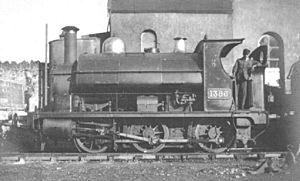
| CMR Number | GWR Number (or where sold) | Year Withdrawn |
| 1 | GWR 1392 | 1906 |
| 2 | GWR 1393 | 1936 |
| 3 | GWR 1394 | 1933 |
| 4 | GWR 1395 | 1934 |
| 5 | GWR 1396 | 1934 |
| 6 | GWR 1397 | 1933 |
| 7 | GWR 1398, sold to Sharpness Docks 1883 | 1924 |
| 8 | GWR 1399 | 1934 |
| 9 | GWR 1400; GWR 1398 from 1912 | 1936 |
| 10 | to Colne Valley and Halstead Railway | 1948 |
| 11 | to Lynn and Fakenham Railway | |
| 12 | to Lynn and Fakenham Railway | |
| 13 | to Lynn and Fakenham Railway | 1898 |
| 14 | to Lynn and Fakenham Railway | |
| 15 | to Lynn and Fakenham Railway | |
| 16 | to Lynn and Fakenham Railway | |
| 17 | to Lynn and Fakenham Railway | |
| 18 | to Lynn and Fakenham Railway | 1898 |
In 1893, the CMR bought another locomotive named Goonbarrow for its new branch line. It was built by Peckett and Sons. This engine became GWR 1388 in 1896.
The Route of the Line
When the CMR first opened its improved lines, they were only for goods and minerals.
Main Line: Fowey to Newquay
Here are some of the stations that were used for passenger services:
- Fowey – This station closed and reopened a few times, finally closing in 1965.
- Par – This was the Great Western Railway station on the main line from 1879.
- St Blazey – This station was called Par until 1878. It closed in 1934.
- Bridges – Renamed Luxulyan in 1905.
- Bugle
- Victoria – Renamed Roche in 1904.
- Halloon – Renamed St Columb Road in 1878.
- Newquay
St Dennis Junction was known as Bodmin Road Junction until 1878.
The line from Fowey climbed steeply towards Par, then went downhill after Pinnock Tunnel. After a flatter section, there was a long climb up the Luxulyan Valley, some parts very steep. After the summit at Roche, the line mostly went downhill to Newquay.
The line between Fowey and St Blazey closed in October 1968. The railway track was removed and the path was made into a road. This road is used by English China Clays International to move china clay. Pinnock Tunnel is now a one-way road tunnel with traffic lights. It is still used today.
Par Harbour had many railway sidings (tracks for parking trains). It was connected to the CMR line from St Blazey.
The semi-roundhouse built by the Cornwall Minerals Railway at St Blazey is still there today. It is used as workshops and is a protected historic building.
See also
 In Spanish: Ferrocarril Minero de Cornualles para niños
In Spanish: Ferrocarril Minero de Cornualles para niños
Images for kids


